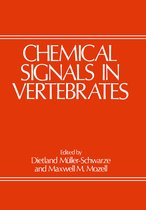Chemical Communication Language of Pheromones
Afbeeldingen
Sla de afbeeldingen overArtikel vergelijken
Auteur:
William C. Agosta
- Engels
- Hardcover
- 9780716750369
- 29 juni 1992
- 180 pagina's
Samenvatting
A wounded minnow attempts to rejoin its school and the other minnows scatter in panic; a single beetle finds a pine tree to its liking and soon thousands of beetles swarm that tree and others in the vicinity; a male Syrian golden hamster is drawn along an invisible trail to a burrow where a female hamster awaits him, ready for mating. These animals are responding to received communications, but, as in countless other occurrences in nature, the language is not auditory or visual--it is chemical.
Unlike humans, who gather information largely through sight and sound, most living creatures rely heavily on chemical compounds from other organisms for their basic knowledge of the world. Among the various types of these compounds are the chemical signals exchanged between members of the same species that govern social interactions crucial to survival. These signals are called pheromones (from the Greek ''pherein''--to carry--and ''hormon''--exciting) and they are used to send warnings, establish territorial boundaries, provoke aggression, control sexual behavior, and locate food. In this volume, organic chemist William C. Agosta explores the chemistry of pheromones and the mechanisms by which they orchestrate animal behavior. Professor Agosta details the intricate process of identifying pheromones: first establishing that some behavior in animals is chemically driven, then isolating pheromones and determining the active components within these sometimes highly complex mixtures. He also demonstrates the value of this growing body of knowledge to our understanding of evolution, ecology, human behavior, and agricultural production. The result is a fascinating look at a research area that brings together investigators, information, technologies, and procedures from the fields of biology, chemistry, and behavioral science.
Chemical Communication spans the entire spectrum of life, from simple organisms, such as water molds and brown algae, to insects, birds, fish, reptiles, mammals, and in a provocative final chapter, human beings. Along the way, Dr. Agosta provides dozens of captivating examples of pheromones in action: certain male red-sided garter snakes, which increase their chances of mating successfully by ''impersonating'' a female, thus distracting rivals; or the bolas spiders, which capture male moths by hitting them with an adhesive ball on a string after emitting a female moth pheromone that lures the males within range. The book also includes important evidence that pheromones alter physiology as well as behavior. For example, young female mice reach maturity at an accelerated pace after constant exposure to adult male mice.
Unlike humans, who gather information largely through sight and sound, most living creatures rely heavily on chemical compounds from other organisms for their basic knowledge of the world. Among the various types of these compounds are the chemical signals exchanged between members of the same species that govern social interactions crucial to survival. These signals are called pheromones (from the Greek ''pherein''--to carry--and ''hormon''--exciting) and they are used to send warnings, establish territorial boundaries, provoke aggression, control sexual behavior, and locate food. In this volume, organic chemist William C. Agosta explores the chemistry of pheromones and the mechanisms by which they orchestrate animal behavior. Professor Agosta details the intricate process of identifying pheromones: first establishing that some behavior in animals is chemically driven, then isolating pheromones and determining the active components within these sometimes highly complex mixtures. He also demonstrates the value of this growing body of knowledge to our understanding of evolution, ecology, human behavior, and agricultural production. The result is a fascinating look at a research area that brings together investigators, information, technologies, and procedures from the fields of biology, chemistry, and behavioral science.
Chemical Communication spans the entire spectrum of life, from simple organisms, such as water molds and brown algae, to insects, birds, fish, reptiles, mammals, and in a provocative final chapter, human beings. Along the way, Dr. Agosta provides dozens of captivating examples of pheromones in action: certain male red-sided garter snakes, which increase their chances of mating successfully by ''impersonating'' a female, thus distracting rivals; or the bolas spiders, which capture male moths by hitting them with an adhesive ball on a string after emitting a female moth pheromone that lures the males within range. The book also includes important evidence that pheromones alter physiology as well as behavior. For example, young female mice reach maturity at an accelerated pace after constant exposure to adult male mice.
Productspecificaties
Wij vonden geen specificaties voor jouw zoekopdracht '{SEARCH}'.
Inhoud
- Taal
- en
- Bindwijze
- Hardcover
- Oorspronkelijke releasedatum
- 29 juni 1992
- Aantal pagina's
- 180
Betrokkenen
- Hoofdauteur
- William C. Agosta
- Hoofduitgeverij
- Scientific American Library
Overige kenmerken
- Studieboek
- Ja
- Verpakking breedte
- 220 mm
- Verpakking hoogte
- 240 mm
- Verpakking lengte
- 240 mm
- Verpakkingsgewicht
- 749 g
EAN
- EAN
- 9780716750369
Je vindt dit artikel in
- Categorieën
- Taal
- Engels
- Boek, ebook of luisterboek?
- Boek
- Beschikbaarheid
- Leverbaar
- Studieboek of algemeen
- Studieboeken
Kies gewenste uitvoering
Kies je bindwijze
(2)
Prijsinformatie en bestellen
De prijs van dit product is 13 euro en 50 cent. Dit is een tweedehands product.Alleen tweedehands
Goed
mooi, net exemplaar
mooi, net exemplaar
Op voorraad
Voor 23:59 uur besteld, woensdag in huis
Verkoop door
Inktswart weeshuis van boeken
- Bestellen en betalen via bol
- Ophalen bij een bol afhaalpunt mogelijk
- 30 dagen bedenktijd en gratis retourneren
- Doordeweeks ook ’s avonds in huis
Shop dit artikel
Rapporteer dit artikel
Je wilt melding doen van illegale inhoud over dit artikel:
- Ik wil melding doen als klant
- Ik wil melding doen als autoriteit of trusted flagger
- Ik wil melding doen als partner
- Ik wil melding doen als merkhouder
Geen klant, autoriteit, trusted flagger, merkhouder of partner? Gebruik dan onderstaande link om melding te doen.









